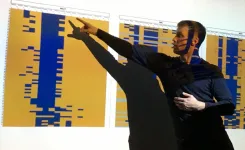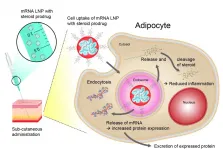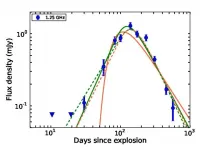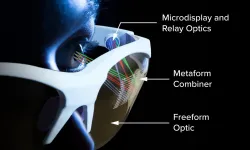European coordination needed to fight science disinformation, academies say
In a new report, ALLEA, the European Federation of Academies of Sciences and Humanities, examines the potential of technical and policy measures to tackle science disinformation
2021-05-03
(Press-News.org) Berlin, 3 May - In a new report, ALLEA, the European Federation of Academies of Sciences and Humanities, examines the potential of technical and policy measures to tackle science disinformation and calls for improved European exchange and coordination in this field.
While disinformation strategies are intoxicating public discourses in many fields, science disinformation is particularly dangerous to democratic governance and society at large. As highlighted by the ongoing pandemic, an undermining of trust in science poses a fundamental threat to political and individual decisions based on evidence and scientific knowledge.
Over the past years, extensive research and a variety of strategies have been developed and applied to tackle science disinformation. ALLEA's paper reviews this work, focusing on the roots and consequences of this multi-dimensional phenomenon, as well as practical solutions for policy, technology and communication.
"The science race against Covid-19 has not only been in the search for a vaccine. Another major risk has mobilised researchers: science disinformation. This report identifies key pathways to counter this 'infodemic' in future global crises. Seeing these problems unfolding in our societies, we need an institutionalised and coordinated strategy to galvanise researchers, communicators, and policymakers into action as early as possible", says ALLEA President Antonio Loprieno.
The authors discuss the most prominent psychological, technical and political strategies to counter science disinformation, including inoculation, debunking, recommender systems, fact-checking, raising awareness, media literacy, as well as innovations in science communication and public engagement.
Following an analysis of the consequences of science disinformation in climate change, vaccine hesitancy and pandemics, the report concludes with a series of recommendations. The authors call for:
a stronger focus on communicating how science works and more dialogue in science communication practices,
a serious engagement with the public when exercising or communicating research,
valuing the virtue of intellectual humility when communicating scientific evidence,
the maintenance of good research practices and high ethical standards to ensure integrity and trustworthiness,
accountable, honest, transparent, tailored and effective science advice mechanisms.
To implement these proposals, the authors advise to establish a European Centre/Network for Science Communication and a European Code of Conduct for Science Communication.
"Even though there seems to be widespread awareness of the problems and harm caused by disinformation, there is still no coordinated European effort to respond to this with increased and better science communication. While mechanisms of science advice for policy have been introduced on different levels to bridge the gap between scientists and policymakers, no central pan-European mechanism or institution is in place to coordinate existing initiatives and develop coherent guidelines and recommendations on science communication in an inclusive manner", the authors argue.
The discussion paper will be presented and debated at the upcoming scientific symposium 'Across Boundaries in Sciences', held online on 5 May, during the 2021 ALLEA General Assembly. Registration is still open at: https://alleageneralassembly.org/
INFORMATION:
Download report at: https://allea.org/fact-or-fake-discussion-paper
[Attachments] See images for this press release:
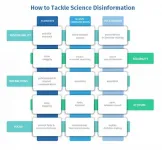
ELSE PRESS RELEASES FROM THIS DATE:
2021-05-03
Impaired bone health is among the most significant long-term consequences of hematopoietic stem cell transplantation (HSCT), a common therapy for patients with malignant and non-malignant haematological diseases.
To address this serious problem, the International Osteoporosis Foundation (IOF) expert Working Group on Cancer and Bone Disease has published a new Executive Summary of its authoritative state-of-the-art review. The review outlined the major factors affecting bone health in HSCT patients, and provided expert guidance for the monitoring, evaluation and treatment of bone loss in these patients. ...
2021-05-03
Globally, tuberculosis is the most common bacterial infectious disease leading to death. The pathogen causing tuberculosis, Mycobacterium tuberculosis, has a number of peculiarities. One is that it is growing very slowly. While other typical pathogens, such as pneumococcal and pseudomonads, can already be identified by their growth in the microbiological laboratory in the first 72 hours, several weeks usually pass before tuberculosis bacteria grow in the lab. Thus it often takes one to two months before the efficacy of individual medicines can be tested.
However, these efficacy tests are essential for the effective treatment of multidrug-resistant tuberculosis (MDR-TB), which is becoming increasingly common. In these cases, the pathogen has become ...
2021-05-03
If not before, then certainly since the first messenger RNA (mRNA) vaccines to combat the SARS CoV2 virus were approved in Germany, mRNA has become a recognized term even outside scientific circles. What is less well known is that mRNA can be used to produce much more than just vaccines. Around 50 different procedures for the treatment of diseases including cancer are already being studied in clinical trials. Scientists from the pharmaceutical company AstraZeneca, with the support of neutron researchers from Forschungszentrum Jülich, have now discovered how the subcutaneous administration of mRNA can be improved. The goal is for chronically ill ...
2021-05-03
Scientists from the National Centre for radio Astrophysics of the Tata Institute of Fundamental Research (NCRA-TIFR) Pune used the upgraded Giant Metrewave Radio Telescope (uGMRT) to determine that AT 2018 cow, the first of a newly discovered class of cosmic explosions, has an extremely patchy environment. Sources like AT 2018cow release an enormous amount of energy, nonetheless fade extremely rapidly. This along with their extremely blue color has led to them being called FBOTs for Fast Blue Optical Transient. This is the first observational evidence of inhomogeneous emission from an FBOT. The origins of FBOTs are still under debate, but proposed models include explosion of a massive star, collision of an accreting neutron star and ...
2021-05-03
"Image" is everything in the $20 billion market for AR/VR glasses. Consumers are looking for glasses that are compact and easy to wear, delivering high-quality imagery with socially acceptable optics that don't look like "bug eyes."
University of Rochester researchers at the Institute of Optics have come up with a novel technology to deliver those attributes with maximum effect. In a paper in Science Advances, they describe imprinting freeform optics with a nanophotonic optical element called "a metasurface."
The metasurface is a veritable forest of tiny, silver, nanoscale structures on a thin metallic film that conforms, in this advance, to the freeform shape of ...
2021-05-03
According to Michael Twidale, professor in the School of Information Sciences at the University of Illinois Urbana-Champaign, bad usability can be an irritation for everyone but "especially awful" for the underprivileged. In "Everyone Everywhere: A Distributed and Embedded Paradigm for Usability," which was recently published in the Journal of the Association for Information Science and Technology (JASIST), Twidale and coauthors David M. Nichols (University of Waikato, New Zealand) and Christopher P. Lueg (Bern University of Applied Sciences, Switzerland) present a new paradigm to address the persistence of difficulties that people have ...
2021-05-03
(New York, NY) - May 3, 2021 - In advance of a wildfire season projected to be among the worst, the American Thoracic Society has released a report that calls for a unified federal response to wildfires that includes investment in research on smoke exposure and forecasting, health impacts of smoke, evaluation of interventions, and a clear and coordinated communication strategy to protect public health.
The report, Respiratory Impacts of Wildland Fire Smoke: Future Challenges and Policy Opportunities, was published online ahead of print in the Annals of the American Thoracic Society on May 3, 2021.
The report comes at a time when the U.S. is experiencing an increasing frequency of very large destructive wildfires, due to years ...
2021-05-03
Over 400 common disinfectants currently in use could be made safer for people and the environment and could better fight the COVID-19 virus with the simple application of UVC light, a new study from the University of Waterloo shows.
Benzalkonium chloride (BAK) is the most common active ingredient in many disinfectants regularly used in hospitals, households, and food processing plants to protect against a wide range of viruses and bacteria - including all strains of SARS-CoV-2, the coronavirus that causes COVID-19 - but its toxicity means that it can't be used in high concentrations. It also means that products containing BAK are harmful to humans ...
2021-05-03
LUGANO, Switzerland, 3 May 2021 - As breast cancer becomes a largely curable disease, with more than 70% of women surviving at least 10 years after diagnosis across most of Europe thanks to early detection and treatment, (1) the quality of life after cancer has become an important aspect of the patient journey - one that may be inadequately addressed with current standards of follow-up. A study presented at the ESMO Breast Cancer 2021 Virtual Congress (2) has shown that breast cancer survivors differ widely in the burden of symptoms they experience after the end of treatment and thereby revealed an unmet need for tailored approaches to follow-up care. (3)
Lead author Kelly de Ligt ...
2021-05-03
TORONTO - Scientists at the Krembil Brain Institute, part of University Health Network (UHN), in collaboration with colleagues at the Centre for Addiction and Mental Health (CAMH), have used precious and rare access to live human cortical tissue to identify functionally important features that make human neurons unique.
This experimental work is among the first of its kind on live human neurons and one of the largest studies of the diversity of human cortical pyramidal cells to date.
"The goal of this study was to understand what makes human brain cells 'human,' and how human neuron circuitry functions as it does," says Dr. Taufik Valiante, neurosurgeon, scientist at the Krembil Brain Institute at UHN and co-senior author on the paper.
"In our study, we wanted ...
LAST 30 PRESS RELEASES:
[Press-News.org] European coordination needed to fight science disinformation, academies say
In a new report, ALLEA, the European Federation of Academies of Sciences and Humanities, examines the potential of technical and policy measures to tackle science disinformation

